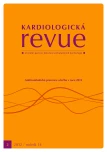Vorapaxar in clinical studies
Authors:
J. Špinar 1; J. Vítovec 2; L. Špinarová 2
Authors‘ workplace:
Interní kardiologická klinika FN Brno, LF MU a ICRC, Brno
1; I. interní kardioangiologická klinika FN u sv. Anny, LF MU a ICRC, Brno
2
Published in:
Kardiol Rev Int Med 2012, 14(2): 109-113
Category:
Reports from Foreign countries
Overview
Current anti-platelet strategies for acute and chronic cases have one serious weakness – the failure of therapy or reduced response to therapy in a significant percentage of patients. The result of this is the ongoing hyperactivity of thrombocytes and the risk of development of thrombotic complications. One practical and logical solution would therefore be the introduction of treatment using more effective substances, such as the now-available prasugrel, an irreversible ADP inhibitor, and ticagrelor, a reversible inhibitor. This article presents the results of a clinical test using vorapaxar (SCH530348), a PAR-1 inhibitor for platelet receptors. The TRACER study is an international clinical study of 12,944 patients with acute coronary syndrome with ST elevations. The study primarily focused on mortality due to cardiovascular causes, myocardial infarctions, strokes, hospitalisation for ischemia or urgent revascularisation. The study was terminated prematurely following evaluation of the safety of medication administered. The addition of vorapaxar to standard therapy did not lead to a significant reduction in the primary goals of the study, but to increased bleeding, including intracranial bleeding. The TRA-2P TIMI 50 study was a multicentric, double-blind study. It focused on patients who suffered myocardial infarction or stroke for a minimum period of 2 weeks and maximum of 12 months following incidence. 26,449 patients were involved in the study. In the 3rd year the primary goal of cardiovascular mortality, myocardial infarction or stroke occurred in 1,028 (9.3%) patients treated with vorapaxar and in 1,176 (10.5%) patients treated with a placebo, a highly significant result in statistical terms (p < 0.001). Historically, the TRA-2P TIMI 50 study is one of most successful in the field, with a major contribution being made by the Czech Republic.
Keywords:
antiaggregate therapy – vorapaxar – myocardial infarction – secondary prevention
Sources
1. Karetová D. Aktuality v antiagregační léčbě. Medicína po promoci 2011; 12: 45–46.
2. Špinar J, Vítovec J. Novinky z American Heart Association 2011. Kardiol Rev 2012; 14: 49–51.
3. Tricoci P, Huang Z, Held C et al. TRACER Investigators. Thrombin-Receptor Antagonist Vorapaxar in Acute Coronary Syndromes. N Engl J Med 2012; 366: 20–33.
4. Morrow DA, Braunwald E, Bonaca MP et al. TRA 2P–TIMI 50 Steering Committee and Investigators. Vorapaxar in the secondary prevention of atherotrombotic events. N Engl J Med 2012; 366: 20–33.
5. Meadows TA, Bhatt DL. Clinical aspects of platelet inhibitors and thrombus formation. Circ Res 2007; 100: 1261–1275.
6. Desai NR, Bhatt DL. The state of periprocedural antiplatelet therapy after recent trials. JACC Cardiovasc Interv 2010; 3: 571–583.
Labels
Paediatric cardiology Internal medicine Cardiac surgery CardiologyArticle was published in
Cardiology Review

2012 Issue 2
Most read in this issue
- Antiaggregating and anticoagulant therapy – basic principles
- Anticoagulant therapy and atrial fibrillation
- Where is a step in the current development of drugs that affect blood clotting?
- Current guidelines for antiplatelet therapy in neurology
